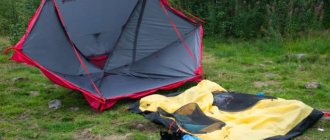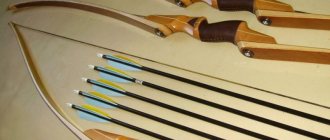Not everyone knows that a boomerang is, in fact, a type of throwing wooden weapon. But the days when it was used as a weapon are long gone. Today it is a toy that not only children, but also adults want. We will tell you how to make a boomerang with your own hands. Boomerangs have become widely known for their ability to return to the place from which a person fired. But there are also boomerangs that do not return (combat boomerangs).
What other boomerangs are there?
A – combat boomerang; B – “pil-pil”; B – “Kylie” boomerang, which, like the “pil-pil”, can return, but only if thrown against the wind; G – sports and hunting returning boomerang; D, E – multi-blade returning boomerangs.
DIY boomerang
You will need:
- Sheet of cardboard;
- Plywood or wood;
- Varnish or paint;
- Jigsaw;
- Plane;
- Sandpaper.
First of all, you need to draw the selected boomerang model exactly in life size on a thick and thin sheet of cardboard. It is recommended to choose a sheet size of 50x60 cm. After this, you need to transfer a grid with a square side of 50 mm onto the cardboard. Next, we redraw the outlines of the boomerang onto it from the drawing shown in the figure.
Schemes for assembling paper boomerangs
The paper boomerang assembly diagram looks like this:
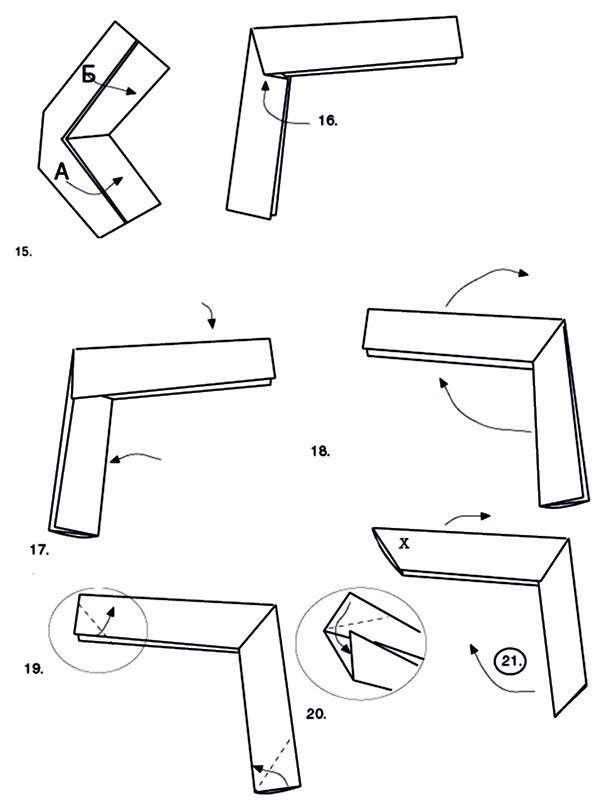
The schematic diagram clearly shows the sequence in which the origami figure is made. After carefully studying the graphic image, even novice origami artists will be able to complete origami production without any problems!
How to make a boomerang from plywood
From the resulting template, we cut out a blank from plywood. Its thickness is 10 mm. Now you need to process the workpiece. This should be done with a small plane in a vice or using the device shown in image (d). The boomerang needs to be planed starting from the middle, moving towards the edges of the blades. Their end should end up being 6mm thick. The blades must be absolutely identical in shape. To simplify the task, you can make counter-templates of the blades from plywood and apply them to check the correctness of the shapes.
The surface should be completely smooth, so the next step will be sanding. To do this, you can use sandpaper. After sanding, the almost finished boomerang is coated with a primer, and then with varnish or paint. It is best to use bright paint so that the boomerang can be seen from afar and is easier to find when it falls. In addition, parquet varnish can be used for coating, which preserves the aesthetic structure of the product. This is how you can relatively easily make a boomerang with your own hands in an hour or two.
How to make a boomerang from wood
If possible, it is recommended to make a boomerang from wood. For this purpose, as a rule, bent branches and roots are used. It is important that the wood is dense, heavy and well dried. The following materials are suitable for making a boomerang: oak, birch, beech, linden. The manufacturing process is exactly the same as in the case of plywood. But it should be remembered that wood deteriorates much faster than plywood, so it must be varnished or painted especially carefully.
Interesting: Easter eggs with leaf prints
If you followed all the rules when creating a boomerang, it will have excellent flight qualities and a beautiful appearance. We figured out how to make a boomerang with our own hands, now we need to figure out how to launch it correctly.
What wood to use
The first step for these purposes is to select a suitable piece of wood curved at 90-100 degrees (“knee”). The most suitable types of wood will be hardwood, such as oak, linden or birch.
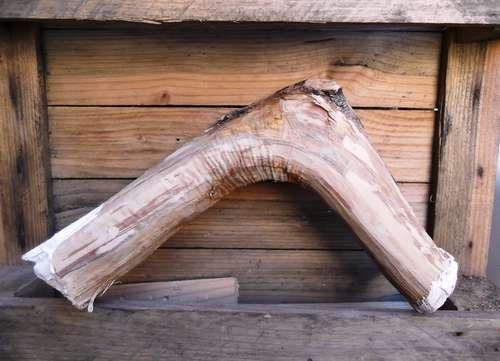
Go to a nearby forest or shelterbelt and start searching for the optimal piece of wood, if possible look for a dry branch. Just don't forget to take a hacksaw or ax with you. It is advisable to choose branches with a diameter of 10 cm in order to be able to make several boomerangs from one piece.
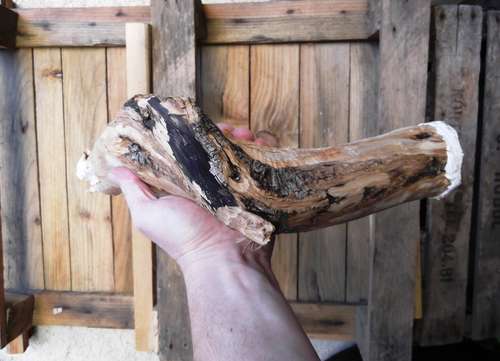
How to launch a boomerang correctly
1. Place for training Launching a boomerang for the first time, despite all its apparent simplicity, is quite dangerous due to unpredictability, so some caution and attention will be required. You can hit someone with a boomerang, so you shouldn’t start experiments in crowded places. The optimal place for training agility and accuracy is a meadow or clearing with a radius of 40-60 meters (the more, the better). In a city, such a clearing could be a football field or a vacant lot.
The launch of a boomerang is specific in that its flight trajectory is a figure eight. Therefore, the person throwing the boomerang should throw it only from the center of the place chosen for training. The projectile will fly forward, making a loop in front of the thrower. He will then return and make the same loop behind the thrower, thereby forming a figure eight, the execution of which depends on several parameters - the force of the throw, the quality of the boomerang, the experience of the thrower.
2. The key to success in the correct grip The boomerang has two main surfaces. The convex front side, on which, as a rule, a design is applied, creates its own effects when rotated. The back side, in most cases, is flat, you can also see a pattern on it, but with proper throwing, usually only the front side can be seen. It is customary to hold a boomerang like this: the thumb always lies on the front side. Holding a boomerang correctly means holding it facing you and seeing the pattern clearly. The boomerang can be held with both the wing backward and the wing forward. This is not important and in any case it is correct - whatever is more convenient for you.
Boomerangs can be light or heavy. You can determine the type yourself - your hand will tell you which boomerang you are holding. A light boomerang in your hand needs to be fixed with three fingers - it is clamped with the middle, thumb and index fingers (it should be recalled that the thumb, with a correct grip, should always lie on the front side).
It is quite difficult to hold a heavy boomerang with three fingers, so it needs to be fixed in the fist, right up to the little finger, i.e. the grip comes out with four fingers, so the fixation is quite rigid. You can grab it deeper, but when throwing the boomerang it will be awkward to release, so it is not recommended to grab heavy boomerangs deeper than four fingers.
3. What angle should the hand have? Many beginners launch a boomerang on a subconscious level, tilting it like a sickle used to cut grass, almost parallel to the ground. This is completely wrong. In a boomerang, the aerodynamics are designed so that throwing it correctly means throwing it almost perpendicular to the horizon, while at the same time the inclination to the horizon line should be to the right of the imaginary perpendicular. The boomerang should be released at an angle of no more than 45° to the horizon during the throw.
Interesting: Silver in radio components
You can come to this experimentally on your own - if the boomerang is tilted too much, it will fly up sharply, and then also dive sharply to the ground in front of the thrower. If the throw is made at an angle of more than 45°, the boomerang will never even come close to returning to the thrower.
4. What should be the throw The boomerang should be thrown sharply and strongly. When launching a boomerang, you need to take into account the fact that the projectile requires force not only to fly away from the thrower, but also to travel back and loop behind the thrower. Therefore, you should throw extremely hard and sharply, especially if for training you use a real wooden boomerang, and not a toy plastic copy. As a rule, the first throws are timid and cautious, especially if a woman or child throws. But don't be afraid! Any high-quality boomerang is designed for a powerful throw, because if you throw it weakly, this will lead to its rapid fall somewhere along the trajectory, which is not very good for it.
You need to throw the boomerang straight in front of you, looking and focusing on the horizon line. There is no need to throw the boomerang up - it is better to throw it straight forward, because the design of the projectile is such that it will independently gain the required height.
5. Spinning the boomerang During the first throws, a situation may arise that you, as it may seem to you, are throwing the boomerang sharply and strongly, but it still flies smoothly, without twisting as required. In this case, you need to master some spinning skills. If you throw the projectile correctly, it will spin as quickly as a propeller - the pattern will merge into a solid circle, the blades will not be visible. To ensure maximum spin, a good grip is essential. In addition, the boomerang should not be buried too much in the fist (the correct grip was described above).
There are many ways to spin a boomerang, but we will focus on the simplest and most common. So, we swing and throw sharply, but at the very last second before the boomerang comes out, you do not let go of your hand completely, but quickly stop it, as if pulling it back. Many of us have used a mercury thermometer, so this movement is familiar to everyone - it completely replicates shaking the thermometer. With such a throw, we leave a kind of trip for the boomerang, cut off the running leg and he, stumbling, rolls head over heels. A boomerang twisted with such a stopper will twist more strongly.
Interesting: Modding the “Mission” system unit case
6. Taking into account the wind We figured out how to launch a boomerang, but we should also take the wind into account. Wind is almost the main factor that influences the flight path of not only a boomerang, but also of all flying projectiles and devices. Its influence should be taken into account when throwing no less than the force of the throw and the correct grip. If the wind is very strong, sharply changing direction and strength (intermittent), it is better to postpone the training and practice the theoretical part again. It is better to start training in calm, windless weather or in light wind that does not change direction. If you are making throws in the wind, then it is recommended to direct the throw towards the wind slightly to the right of its movement. With such a throw, the wind will help the boomerang return to the thrower. Among other things, the wind has a strong influence on the accuracy of the return of the projectile, because the behavior of any aircraft depends on the available air currents. You can make friends with the wind, but this comes only with experience and after numerous trainings. It is simply impossible to comprehend this art the first time.
Let's sum it up
Let us note the main rules for handling a boomerang:
- The boomerang should be thrown from the center of a deserted place with a radius of at least 40-60 meters;
- For a proper grip, the thumb should be on the front side;
- When throwing a boomerang, you need to tilt it to the horizon from 90° to 45°, otherwise the projectile will simply stick into the ground;
- The correct throw is sharp and strong, pulling back. In this case, the boomerang twists well;
- If you are training in windy weather, then the throw should be directed against the wind slightly to the right.
Only perseverance and patience, dedication and perseverance will help you gain some experience and learn how to throw a boomerang correctly. It can fly perfectly in both winter and summer, you can always practice, but it’s better not in deep snow conditions.
Throwing a wooden boomerang is an ancient method of communicating with the world and the surrounding nature. If you practice persistently, you will soon be able to understand wind, air currents and other elements of nature. Over the years, many people have successfully mastered this art and continue to learn it.
You have successfully been able to familiarize yourself with the theoretical part by reading this manual, so it’s time to move on to the important and main part - the practical one. Practice and experience will teach you the art of boomerang throwing, bringing unique pleasure from the process of unifying with the world around you.






